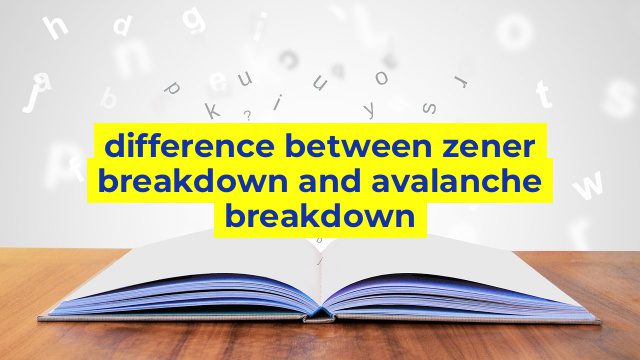Difference between Zener Breakdown and Avalanche Breakdown
When it comes to the functioning of semiconductors, there are a variety of breakdown mechanisms. Among them, two of the most common types of breakdown are Zener breakdown and Avalanche breakdown. Understanding the difference between these two mechanisms is crucial in choosing the right type of diode for a particular application. In this article, we’ll explain the difference between Zener breakdown and Avalanche breakdown.
What is Zener Breakdown?
Zener breakdown is a phenomenon that occurs in heavily doped junction diodes when the reverse voltage applied to the diode is above the Zener voltage. Unlike normal diodes, Zener diodes are designed to operate in the reverse-bias mode. When the applied voltage is raised above the Zener voltage, the electrical field across the junction becomes strong enough to pull the electrons out of the covalent bonds, thus allowing a large amount of current to flow through the device. This mechanism is called as the Zener breakdown.
Zener diodes are commonly used in voltage regulation circuits, where they are used to stabilize the output voltage by limiting the voltage drop across the diode. They are also used in surge protectors, ESD protection circuits, and many other applications.
What is Avalanche Breakdown?
Avalanche breakdown, on the other hand, is the phenomenon that occurs in lightly doped diodes when the reverse voltage applied to the diode exceeds the breakdown voltage. In this mechanism, the electrons that are released due to the strong electric field gain enough kinetic energy to excite other atoms, leading to the creation of more free electrons. This feedback loop generates a high current flow and ultimately destroys the diode.
Avalanche breakdown is commonly used in avalanche diodes, which are designed to operate in the reverse-bias mode. These diodes are used in high voltage applications, where they are used to protect equipment by clamping voltage surges to safe levels.
Key Differences between Zener Breakdown and Avalanche Breakdown
The primary differences between Zener breakdown and Avalanche breakdown can be summarized as follows:
– Zener breakdown occurs in heavily doped diodes, while Avalanche breakdown occurs in lightly doped diodes.
– Zener breakdown happens when the applied voltage is above the Zener voltage, whereas Avalanche breakdown occurs when the applied voltage exceeds the breakdown voltage.
– Zener breakdown is a reversible process, and the diode can return to its original state once the reverse voltage is removed. In contrast, Avalanche breakdown is an irreversible process, and the diode cannot be used again once it has undergone Avalanche breakdown.
– Zener breakdown is used in voltage regulation circuits and surge protectors, while Avalanche breakdown is used in high voltage protection circuits.
In conclusion, Zener breakdown and Avalanche breakdown are two of the most common mechanisms in diodes. By understanding their differences, it is possible to select the right type of diode for a particular application.
Table difference between zener breakdown and avalanche breakdown
| Feature | Zener breakdown | Avalanche breakdown |
|---|---|---|
| Definition | Breaking down of a p-n junction due to the Zener effect | Breaking down of a p-n junction due to avalanche effect |
| Type of breakdown | Due to quantum tunneling | Due to ionization |
| Voltage | Occurs at a specific voltage called Zener voltage | Occurs at a voltage higher than the Zener voltage |
| Polarity | Can occur in both forward and reverse bias | Only occurs in reverse bias |
| Temperature dependence | Less dependent on temperature | More dependent on temperature |
| Current | Current remains constant after breakdown | Current increases rapidly after breakdown |

